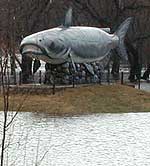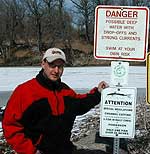By Bob Reha
Minnesota Public Radio
May 6, 2002
For the people who live along the Red River of the North, the stream is one of two things - a flooding nightmare or a world-class fishery. It's always the flooding that gets the most attention. In 1997, the Red River drew national attention when the water rose higher than it ever had before. The flooding caused millions of dollars in damage.
For years, outdoor magazines and sport fishing groups have consistently ranked the Red as one of the nation's best catfishing streams.
| |||
| |
|
||
|
|||
The Red River of the North starts where two rivers meet. At the confluence of the Bois De Sioux and Otter Tail Rivers, the stream seems innocent. The Red meanders north toward Canada. It's a lazy stream. Usually, it's so narrow you can toss a rock across it.
But appearances are deceiving. Almost every year, the Red River floods. Five years ago, the Red flooded worse than it ever had. The quiet little river spread out over the entire Red River Valley - in some places, the river was more than a mile wide.
The cities and towns along the river are still recovering. Neighborhoods were moved. Lives were altered. Buildings were destroyed and rebuilt. All that has made news for years. But there's a part of the story people are hesitant to talk about. It's the story about why floods are good.
"Floods actually are important for maintaining the natural regimen out there in the ways that rivers work," says Dan McGuinness of the National Audobon Society.
McGuiness has studied floods and their effects for more than 30 years. It's tough work. There's an oozing sludge-like mud that coats everything. McGuiness says it's always hard for people to understand, that rivers need to flood.
| |
|
|
|
||
"It needs a periodic rise in water level conditions - like the spring flood - to actually move nutrients around in the flood plain," says McGuinness. "A healthy flood plain is not just sterile mud, it's mud mixed with plants, seeds - it's mixed with organic material that supports plant growth."
McGuiness says floods also help fisheries. High water distributes nutrition to the surrounding land. It also creates cover and spawning beds for fish.
"The catfish in the Red River - they're starting to realize that it's actually a world class fishery," says Doug Leier, an outreach biologist for the North Dakota Game and Fish Department.
Leier says although local residents have been slow to appreciate the quality of fishing on the Red, it's hardly been a secret.
"For years, people that lived from Iowa to Missouri - where they've been catfishing for years on end - they've been coming up here," says Leier. "The residents of North Dakota and Minnesota along the Red River finally realized, 'Hey, these guys are on to something.' This catfishing is fun, and catfish is very tasty table fare."
Years ago, the river was different than it is today. Some communities had garbage dumps on the river. The water was dark, the color of root beer. It made people think it was polluted beyond hope. The general attitude was - who cares.
"People's attitudes are starting to change, and I think part of that has been done through education," says Christine Holland, project coordinator for River Keepers.
| |
|
|
|
||
River Keepers is a non-profit organization in Fargo. It's mission is simple - to establish a renewed vision of the Red River.
River Keepers is doing many things to achieve that goal. It conducts fishing clinics for kids, as well as canoe and kayak classes. Every chance they get, the members of River Keepers talk about the Red. They talk at schools and service clubs. And wherever they go, they teach.
Holland talks a lot about water quality. She says the river's murky appearance comes from clay soil. Many people are shocked to discover the river bed is also gravel and rock. Christine Holland says the most effective tool is getting out on the water. Someone always asks questions about the storm drains.
"You see these big pipes with...water draining out of it, or plastic in the grates and those types of things. And they say, 'What is that?' And I say, whatever goes down the storm drains and the streets goes directly here, and they go, 'Wow,'" Holland says.
Holland says that scene makes a big impression, especially on the kids. They're even more amazed when they find out Fargo's drinking water comes from the Red River.
Changes in attitude occur slowly. But it is happening. Future plans for the Red River include more parks, hiking and boat ramps. There's talk of establishing a series of greenways throughout the valley.
More from MPR


